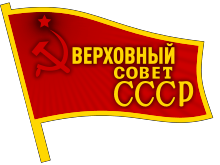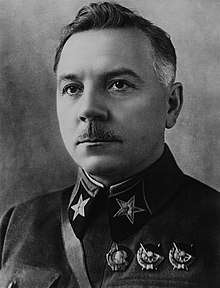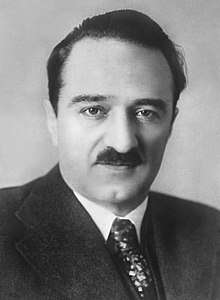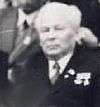Presidium of the Supreme Soviet
The Presidium of the Supreme Soviet (Russian: Президиум Верховного Совета or Prezidium Verkhovnogo Soveta) was a body of state power in the Union of Soviet Socialist Republics (USSR).[1] The presidium was elected by joint session of both houses of the Supreme Soviet to act on its behalf while the Supreme Soviet was not in session. By the 1936 and 1977 Soviet Constitution the Presidium of the Supreme Soviet served as the collective head of state of the USSR.[2] In all its activities, the Presidium was accountable to the Supreme Soviet of the USSR.[1]
Presidium of the Supreme Soviet Президиум Верховного Совета | |
|---|---|
| collective head of state | |
 | |
| History | |
| Established | 1938 |
| Disbanded | 1991 |
| Preceded by | Central Executive Committee of the Soviet Union |
| Succeeded by | President of the Soviet Union |
| Seats | 37 |
| Elections | |
| Election by joint session of both houses of the Supreme Soviet | |
| Meeting place | |
 | |
| Kremlin Presidium, Moscow Kremlin 55.7523°N 37.6200°E | |
| This article is part of a series on the |
| Politics of the Soviet Union |
|---|
 |
|
Leadership |
|
Governance |

Beside the all-Union body there also were in all union republics (e.g., Presidium of the Supreme Soviet of the Byelorussian SSR) and other regions including autonomous republics. Structure and functions of the presidiums in these republics were virtually identical.[3]
During discussions in regards to adaptation of the 1936 Constitution of the Soviet Union, on proposition to elect chairperson of the Presidium by whole population of the country as in the United States the President, Stalin argued: "In the system of our Constitution, in the USSR (Soviet Union) should not be a president in one person elected by whole population equally with the Supreme Council and able to oppose to the Supreme Council. The experience of history shows that such a construction of the supreme organs is the most democratic, guaranteeing the country from undesirable accidents."[4]
The building of the Presidium
Its building, situated inside the Moscow Kremlin, was appropriately named the Kremlin Presidium.
The Presidium of the Supreme Soviet was elected by the Supreme Soviet of the USSR at a joint session of both chambers at the first session of each after convocation. The deputies of the Presidium were appointed for the duration of the term of office of the Supreme Soviet. The Presidium of the Supreme Soviet of the USSR consisted of a chairman, a first vice-chairman (since 1977), his 15 deputies (one from each republic), a secretary, and 20 members. The Presidium was accountable to the Supreme Soviet of the USSR for all its activities.
From 1936 to 1989, the chairman of the Presidium was reckoned as the Soviet Union's de jure head of state, and was sometimes referred to as the "president of the Soviet Union" in non-Soviet sources.
Constitutional powers
At inception
According to the 1936 Constitution of the USSR, as in force as enacted originally (and thus, at the establishment of the Presidium), the basic powers of the Presidium of the Supreme Soviet of the USSR were:
- promulgation of decrees (ukases);
- interpretation of current Soviet laws;
- dissolution of the Supreme Soviet of the USSR on the basis of Article 47 of the 1936 Constitution of the USSR and scheduling new elections: implementing a national referendum on its own initiative or at the request of one of the republics of the Union;
- abrogation of decrees, issued by the Council of Ministers and Council of Ministers of the republics of the Union in case there is a discrepancy with the law;
- relieving the Premier of the Council of Ministers of his job and appointing Ministers of the USSR (between sessions of the Supreme Soviet) with the subsequent submittal for the Supreme Soviet’s approval;
- establishment of orders and medals of the USSR and implementing the awarding procedures;
- establishment of honorary titles of the USSR and their assignment;
- realization of the right to pardon;
- appointment and dismissal of the executive command of the Soviet Armed Forces;
- establishment of military and diplomatic ranks and other special ranks;
- declaration of the general and partial mobilization;
- declaration of war in case of an attack on the USSR or in case when it was necessary to implement obligations of international mutual defense treaties;
- ratification and denunciation of international treaties, signed by the USSR;
- representation of the Supreme Soviet of the USSR (between its sessions) in its relations with parliaments of foreign countries;
- appointment and dismissal of Soviet plenipotentiaries in foreign countries;
- receiving of Letters of Credence and Letters of Recall from foreign diplomatic representatives, accredited in the USSR;
- declaration of the martial law in a given region or across the USSR in the interest of defending the USSR or preserving public order and state security.
The presidium also dealt with questions regarding the acquisition of the Soviet citizenship, its forfeiting or voluntary rejection.
At abolition
According to the 1977 Constitution of the USSR, as in force at the union's dissolution (and thus, at the abolition of the Presidium), the basic powers of the Presidium of the Supreme Soviet of the USSR were:
- organization of the work of the Supreme Soviet;
- preparation of meetings of the Congress of People's Deputies and sessions of the Supreme Soviet;
- coordination of the work of the committees of the Supreme Soviet;
- organization of nationwide discussion of legislative bills and "other very important matters of state".
By then, most of the Presidium's former powers were reassigned to the whole Supreme Soviet and to the President of the USSR.
List of chairmen
| No. [note 1] |
Name (Birth–Death) |
Portrait | Term of office | Supreme Soviet Convocations [note 2] |
|---|---|---|---|---|
| 1 | Mikhail Kalinin (1875–1946)[5] |
.jpg) |
17 January 1938 – 19 March 1946 | 1st Convocation |
| 2 | Nikolay Shvernik (1888–1970)[6] |
 |
19 March 1946 – 15 March 1953 | 2nd–3rd Convocation |
| 3 | Kliment Voroshilov (1881–1969)[7] |
 |
15 March 1953 – 7 May 1960 | 3rd–5th Convocation |
| 4 | Leonid Brezhnev (1906–1982)[8] |
.jpg) |
7 May 1960 – 15 July 1964 | 5th–6th Convocation |
| 5 | Anastas Mikoyan (1895–1978)[9] |
 |
15 July 1964 – 9 December 1965 | 6th Convocation |
| 6 | Nikolai Podgorny (1903–1983)[10] |
 |
9 December 1965 – 16 June 1977 | 6th–9th Convocation |
| (4) | Leonid Brezhnev (1906–1982)[8] |
.jpg) |
16 June 1977 – 10 November 1982 | 9th–10th Convocation |
| — | Vasili Kuznetsov (1901–1990)[11] |
10 November 1982 – 16 June 1983 | 10th Convocation | |
| 7 | Yuri Andropov (1914–1984)[12] |
 |
16 June 1983 – 9 February 1984 | |
| — | Vasili Kuznetsov (1901–1990)[11] |
9 February 1984 – 11 April 1984 | 11th Convocation | |
| 8 | Konstantin Chernenko (1911–1985)[12] |
 |
11 April 1984 – 10 March 1985 | |
| — | Vasili Kuznetsov (1901–1990)[11] |
10 March 1985 – 27 July 1985 | ||
| 9 | Andrei Gromyko (1909–1989)[13] |
 |
27 July 1985 – 1 October 1988 | |
| 10 | Mikhail Gorbachev (born 1931)[14] |
.jpg) |
1 October 1988 – 25 May 1989 | 11th–12th Convocation |
| Chairman of the Supreme Soviet (1989–1990)[note 3] | ||||
| Mikhail Gorbachev (born 1931)[14] |
.jpg) |
25 May 1989 – 15 March 1990 | 12th Convocation | |
List of vice chairmen
There have been four individuals appointed vice head of state. At over eight years, Vasily Kuznetsov spent the longest time in office. Gennady Yanayev spent the shortest time in office.
| No. [note 1] |
Name (Birth–Death) |
Portrait | Term of office | Convocations [note 2] |
|---|---|---|---|---|
| First Vice Chairman of the Presidium of the Supreme Soviet (1977–1989) | ||||
| 1 | Vasili Kuznetsov (1901–1990)[11] |
7 October 1977 – 18 June 1986 | 9th–11th Convocation | |
| 2 | Pyotr Demichev (1917–2010)[16] |
— | 18 June 1986 – 1 October 1988 | 11th Convocation |
| 3 | Anatoly Lukyanov (1930–2019)[17] |
 |
1 October 1988 – 25 May 1989 | 11th–12th Convocation |
| Vice Chairman of the Supreme Soviet (1989–1990) | ||||
| Anatoly Lukyanov (1930–2019)[17] |
 |
25 May 1989 – 15 March 1990 | 12th Convocation | |
| Vice President (1990–1991) | ||||
| 4 | Gennady Yanayev (1937–2010)[18] |
27 December 1990 – 21 August 1991[note 4] | 12th Convocation | |
| — | Office abolished[20] | 21 August 1991 – 26 December 1991[note 5] | ||
See also
Notes
- Repeat head of state and vice heads of state are numbered only once; subsequent terms are marked with their original number italicised. Acting heads of state are not numbered. These numbers are not official.
- A convocation in the Soviet sense of the word were elected members of Parliament in between elections.
- On 15 March 1990 most constitutional powers were transferred to the newly created office of President of the Soviet Union. Anatoly Lukyanov was elected Chairman of the Supreme Soviet to replace Mikhail Gorbachev. Although the Chairman's office retained its name, it was now that of a parliamentary speaker, not a head of state. Real executive powers were retained by Gorbachev.[15]
- Yanayev was Acting President of the Soviet Union during the August Coup of 1991, but was jailed following the coup's collapse and Gorbachev returned to his post as President.[19]
- Following the failed August Coup of 1991 the State Council was given the power to elect a Vice President in the temporary absence of the President.[20]
References
- The Presidium of the Supreme Council of the USSR (ПРЕЗИДИУМ ВЕРХОВНОГО СОВЕТА СССР). Great Soviet Encyclopedia. (in Russian)
- Ideology, Politics, and Government in the Soviet Union: An Introduction– Google Knihy. Books.google.cz. January 1, 1978. Retrieved 2016-11-26.
- Where nation-states come from: institutional change in the age of nationalism by Philip G. Roeder, p. 70
- The history of one Constitution: why comrade Stalin declined the post of president (История одной Конституции: почему товарищ Сталин отказался от поста президента). MKRU (Moskovskiy Komsomolets). 22 March 2020
- Shepilov, Dmitri; Austin, Anthony; Bittner, Stephen (2007). The Kremlin's Scholar: A Memoir of Soviet Politics under Stalin and Khrushchev. Yale University Press. p. 413. ISBN 978-0-300-09206-6.
- Shepilov, Dmitri; Austin, Anthony; Bittner, Stephen (2007). The Kremlin's Scholar: A Memoir of Soviet Politics under Stalin and Khrushchev. Yale University Press. p. 441. ISBN 978-0-300-09206-6.
- Shepilov, Dmitri; Austin, Anthony; Bittner, Stephen (2007). The Kremlin's Scholar: A Memoir of Soviet Politics under Stalin and Khrushchev. Yale University Press. p. 406. ISBN 978-0-300-09206-6.
- Bliss Eaton, Katherine (2004). Daily Life in the Soviet Union. Greenwood Publishing Group. p. 29. ISBN 978-0-313-31628-9.
- Shepilov, Dmitri; Austin, Anthony; Bittner, Stephen (2007). The Kremlin's Scholar: A Memoir of Soviet Politics under Stalin and Khrushchev. Yale University Press. p. 404. ISBN 978-0-300-09206-6.
- Ploss, Sidney (2010). The Roots of Perestroika: the Soviet Breakdown in Historical Context. McFarland & Company. p. 218. ISBN 978-0-7864-4486-1.
- Кузнецов Василий Васильевич [Vasili Vasilyevich Kuznetsov] (in Russian). World History on the Internet. Retrieved 7 December 2010.
- Ploss, Sidney (2010). The Roots of Perestroika: the Soviet Breakdown in Historical Context. McFarland & Company. p. 216. ISBN 978-0-7864-4486-1.
- Ploss, Sidney (2010). The Roots of Perestroika: the Soviet Breakdown in Historical Context. McFarland & Company. p. 217. ISBN 978-0-7864-4486-1.
- Bliss Eaton, Katherine (2004). Daily Life in the Soviet Union. Greenwood Publishing Group. p. 32. ISBN 978-0-313-31628-9.
- Anderson, John (1994). Religion, state, and politics in the Soviet Union and successor states. Cambridge University Press. p. 188. ISBN 978-0-521-46784-1.
- Петр Демичев : Умер министр культуры СССР Петр Демичев [The Minister of Culture of the USSR Pyotr Demichev dies] (in Russian). Peoples.ru (Lenta.Ru). Archived from the original on 16 July 2011. Retrieved 8 December 2010.
- Evtuhov, Catherine; Stites, Richard (2004). A History of Russia: Peoples, Legends, Events, Forces since 1800. Houghton Mifflin Harcourt. p. 474. ISBN 978-0-395-66073-7.
- Schwirz, Michael (24 September 2010). "Gennadi I. Yanayev, 73, Soviet Coup Plotter, Dies". The New York Times. Retrieved 8 December 2010.
- Staff writer (10 February 2011). "Soviet Coup Leader Gennady Yanayev Dies". BBC Online. Retrieved 8 December 2010.
- Government of the USSR: Gorbachev, Mikhail (5 September 1991). Закон "Об органах государственной власти и управления Союза ССР в переходный период" [Law: On the bodies of State Authority and Administration of the USSR in the Period of Transition] (in Russian). Soyuz Sovietskikh Sotsialisticheskikh Respublik. Retrieved 13 February 2011.